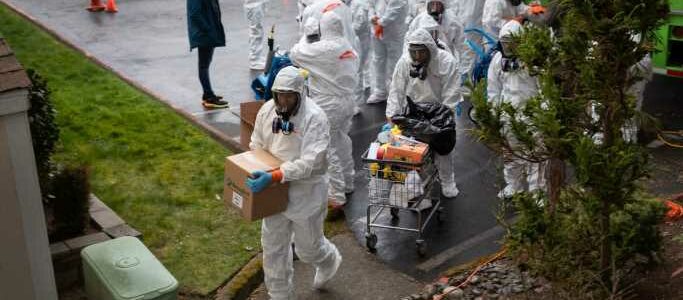
This Is the State Getting the Most COVID-19 Vaccines From the Federal Government
It has now been 30 weeks since the first shipments of the COVID-19 vaccine were sent out to states, kicking off the largest vaccination campaign in human history. As of July 11, 387,006,120 doses of the vaccine have been sent out across the country — equivalent to 117.9% of the U.S. population.
While the initial distribution of the vaccine took longer than federal projections had indicated, in recent months the U.S. has made great leaps in the worldwide race to administer vaccinations — and some states are faring far better than others. Under the current system, led by the White House COVID-19 Response Team, the Centers for Disease Control and Prevention sends states limited shipments of the vaccine as well as funding and tasks them with distributing the vaccine in accordance with relatively loose federal guidelines. The distribution of the vaccine is based on the size of the adult population in every state, which — according to some experts — can create inequities in states where a larger share of the population is at risk.
At this stage of the vaccine rollout, distribution of the vaccine varies widely from state to state. While the CDC has so far sent out an average of 117,903.6 vaccine doses per 100,000 Americans, Vermont has received 149,294 doses per 100,000 residents — the most of any state. Meanwhile, Louisiana has received 88,549 doses per 100,000, the fewest of any state.
The largest outlier is Wyoming, which has received the second fewest doses per capita and is the smallest state.
While the federal government distributes vaccines to states, it is up to state governments to administer the vaccine — creating variations in both the percentage of vaccines that have been administered and the percentage of the population that has been vaccinated. In New Mexico, 99.9% of vaccine doses have been administered, the most of any state and far greater than the 86.3% national average. In Alabama, 70.1% of vaccine doses have been administered, the least of any state.
At this stage of the rollout, the number of doses administered in Vermont is equivalent to 137.8% of the state population — the largest share of any state. The lowest vaccination rate is in Mississippi, where 68.5% of residents have received a dose of the vaccine. Nationwide, the number of doses administered is equivalent to 101.8% of the U.S. population.
While a majority of Americans remain unvaccinated due to a lack of supply, there are some who have no plans to receive a vaccine at all. According to a survey from the U.S. Census Bureau, 44.6% of U.S. adults 18 and over who have not yet received the vaccine will either probably not or definitely not get a COVID-19 vaccine in the future. The most common reason cited for not wanting a vaccine was being concerned about possible side effects. Other commonly cited reasons include that they were planning to wait and see if it is safe, not trusting COVID-19 vaccines, and not trusting the government.
To determine the states getting the most vaccines from the federal government, 24/7 Wall St. reviewed data from the Centers for Disease Control and Prevention. States were ranked based on the number of vaccines administered as of July 11 per 100,000 residents. Vaccine counts were adjusted for population using one-year data from the Census Bureau’s 2019 American Community Survey. Data on confirmed COVID-19 cases as of July 11 came from various state and local health departments and were adjusted for population using 2019 ACS data. Data on the percentage of adults who probably will not or definitely will not get a COVID-19 vaccine and their reasons for not getting one came from the Census Bureau’s Household Pulse Survey, conducted from May 12, 2021 to May 24, 2021.
Source: Read Full Article